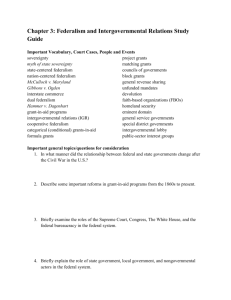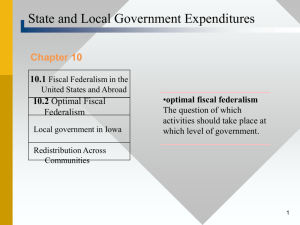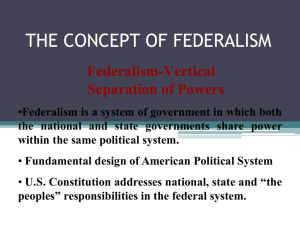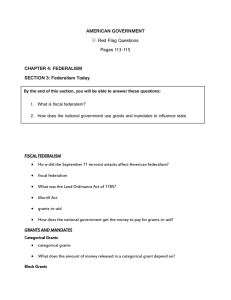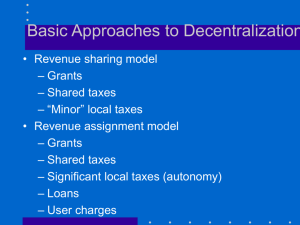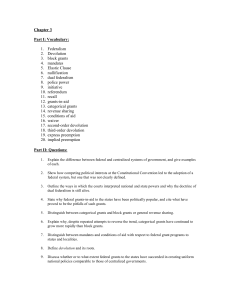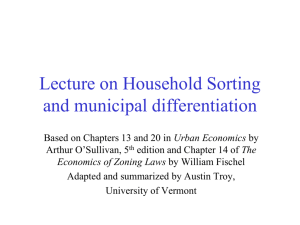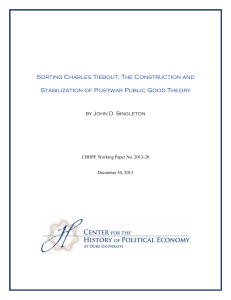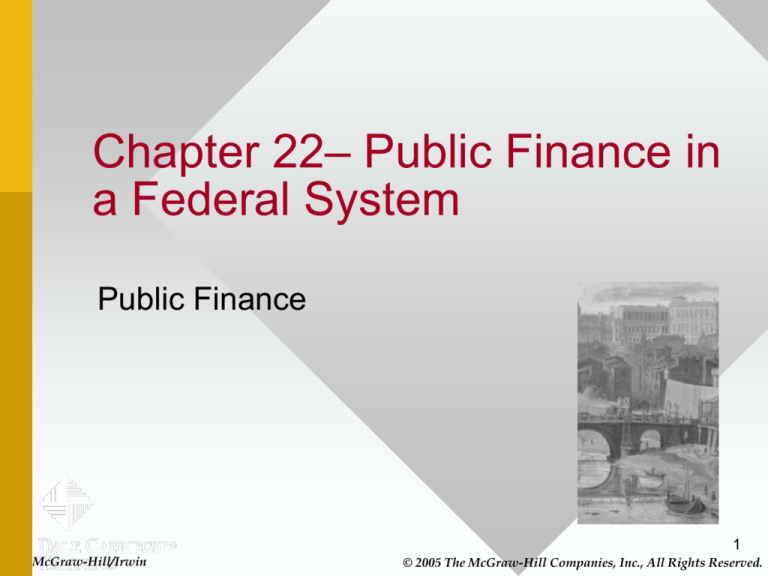
Chapter 22– Public Finance in
a Federal System
Public Finance
1
McGraw-Hill/Irwin
© 2005 The McGraw-Hill Companies, Inc., All Rights Reserved.
Introduction
• This chapter will address questions
related to different levels of government:
– How should various responsibilities be
allocated to different levels of government?
– Is decentralized government decision making
desirable?
– Are locally raised taxes a good way to pay for
services provided locally?
2
Background
• A federal system consists of different
levels of government that provide public
goods and services and have some
scope for making decisions.
• Fiscal federalism explores roles of
different levels of government and how
they relate to one another.
3
Table 20.1
Table 20.2
Subnational government spending/revenue as a
share of total government spending/revenue,2001
Spending %
Greece
Revenue %
5.0
3.7
Portugal
12.8
8.3
France
18.6
13.1
Norway
38.8
20.3
United States
40.0
40.4
Denmark
57.8
34.6
OECD Average
32.2
21.9
5
Fiscal Federalism Abroad
• The higher level of centralization in other
nations exists because state/local governments
have almost no legal power to tax citizens.
• Many countries practice fiscal equalization,
whereby the national government distributes
grants to sub-national government in an effort
to equalize differences in wealth.
6
Fiscal Federalism Abroad
• There has been a move toward decentralization
around the world.
• In the U.S., there have been increased efforts to
shift control and financing of public programs
to the states, such as with welfare reform in
1996.
7
OPTIMAL FISCAL FEDERALISM
Public goods provision problem compounded with issues of
split levels of government
• What is the optimal division of responsibilities
across different levels of government?
• A theory of how the efficiency of public
goods provision may differ at different levels
of government helps answer this questions.
8
OPTIMAL FISCAL FEDERALISM
• Two of the major problems in public goods
provision are:
– Preference revelation: Difficult to design democratic
institutions to cause individuals to reveal their
preferences honestly.
– Preference aggregation: Difficult to aggregate
individual preferences into a social decision.
9
The Tiebout Model
• A number of activities are run primarily at the
state and local levels.
– Education
– Public safety
– Highways
– Public welfare
10
The Tiebout Model
• Tiebout (1956) argued that the ability of individuals
to move across jurisdictions produces a market-like
solution to the local public goods problem.
• Tiebout showed that the inefficiency in public goods
provision came from two missing factors: shopping
and competition.
• Shopping induces efficiency in private markets.
• Competition induces the right prices and quantities in
private markets.
11
The Tiebout Model
• With public goods provided at the local level,
competition naturally arises because individuals can
vote with their feet by moving to another town without
much disruption.
• This induces fiscal discipline for local governments
and creates a new preference revelation device: mobility.
• Tiebout argued that the threat of exit can induce
efficiency in local public goods production.
• Under certain (unrealistic) conditions public goods
provision will be fully efficient at the local level.
12
The Tiebout Model
• Voting with your feet
• Tiebout’s assumptions
– Government activities generate no externalities
– Individuals are completely mobile
– People have perfect information with respect to each
community’s public services and taxes
– There are enough different communities so that each individual
can find one with public services meeting her demands
– The cost per unit of public services is constant so that if the
quantity of public services doubles, the total cost also doubles
– Public services are financed by a proportional property tax
– Communities can enact exclusionary zoning laws—statutes that
prohibit certain uses of land
13
Problems with the Tiebout Model
• Tiebout competition may not hold because:
– It requires perfect mobility.
– It requires perfect information on the benefits
individuals receive and the taxes they pay.
– It requires enough choice of towns so that
individuals can find the right levels of public
goods.
14
Problems with the Tiebout Model
• Tiebout financing is problematic because:
– It requires lump-sum taxes that are independent
of a person’s income. This is viewed as highly
inequitable.
– It is more common for towns to finance public
goods through proportional taxes on homes,
leading to the problem of the poor chasing the rich.
– The use of zoning can ameliorate this problem.
15
Optimal Federalism: what level
should provide which services?
• What is the optimal allocation of
economic responsibilities among levels of
government in a federal system?
• Will discuss the advantages and
disadvantages of a decentralized system.
16
Optimal Fiscal Federalism
• First, the model implies that the extent to which public goods
should be provided at the local level is determined by taxbenefit linkages.
• Strong linkages (such as local roads) means most residents
benefit, and the good should be provided locally.
• Weak linkages (such as welfare payments) means that most
residents do not benefit, and the good should be provided at a
higher level.
• If residents can see directly the benefits they are buying with
their property tax dollars, they will be willing to pay local taxes.
Otherwise, they may “vote with their feet.”
17
Optimal Fiscal Federalism
• The second factor that determines the optimal level
of decentralization is the extent of positive
externalities.
• If the local public good has spillovers to other
communities, they will be underprovided. In this
case, higher levels of government have a role in
promoting the provision of these public goods.
18
Optimal Fiscal Federalism
• The third factor that determines the optimal level
of decentralization is the economies of scale in
production.
• Public goods with large economies of scale, like
national defense, are not efficiently provided by
many competing local jurisdictions.
• Public goods without large economies of scale,
like police protection, may be provided more
efficiently in Tiebout competition.
19
Optimal Fiscal Federalism
• The Tiebout model therefore predicts that
local spending should focus on broad-based
programs with few externalities and relatively
low economies of scale.
• Examples include road repair, education,
garbage collection, and street cleaning.
20
The Property Tax
• In 2005, $320 billion collected in property
taxes, almost all at the local level.
• Plays key role in local public finance.
• In many western states with public lands,
feds make payment in lieu of taxes
• Many non-profits also make payments in
lieu of taxes
21
22
The Property Tax
• Property tax liability is the product of the tax rate
and the property’s assessed value.
– Value the jurisdiction assigns to property.
• In many cases, assessed values correspond to
market values, but more difficult if a property has
not been sold recently.
• Wide range of credits and rollbacks can change
the effective tax rate
23
The Property Tax
• Table 20.2 shows that effective tax rates
on residential property vary widely.
24
Table 20.2
26
Property taxes
• American system of local property taxes originates
with British traditions
• Importance linked to growth of frontier
• Feasible source of revenue
– Equal taxation of wealth
– Overlapping and special districts had revenue sources
• Colonial era had several taxes
– Excise and tariffs
• Post revolutionary war saw a uniformity clause added
to property taxation
27
Property taxes
• Property taxes applied to real estate and
personal property
• Individuals paid for government services
in proportion to their wealth
28
Property tax and local governments
• 87,500 local governments in 2002
– Special districts increasing
• “reserved powers” clause of 10th amendment to
US Constitution
– States can permit anything not excluded by Feds
– Local governments are creatures of State govt.
• Diversity of local government related to history,
settlement patterns and state legislatures
29
Local government trends
• Local government structure continues to evolve
– De-volution or de-centralization trends
– Number and scope of local governments
– Style of state legislature
– Political culture of the state.
• Local government will continue to be important
– Local government revenue will be needed
– Property tax will continue to be important
30
Evolution of the property tax system
• In agricultural economy, wealth mostly tied to land and
buildings
• In modern commercial society, wealth in many other
forms (stocks, bonds, investments,
• Local assessors often played favorites with property
valuations
• Auditor, treasurer are separate elected offices
• Wages and earnings as new form of wealth
• Increased demands for revenues for services
31
Property tax history
• Post WW2 saw dramatic changes in
growth and demand for services
• Assessments and revenues grew
• Local programs and services also grew
32
California Tax Revolt
• Proposition 13
– Froze assessments at 1975 levies (until next
transaction)
– Ceiling on the property tax rate any locality
could impose
– Forbade localities raising property taxes
without a 2/3 majority
• State stepped in with more revenue
sharing
33
Why property taxes are
controversial in US and Iowa
• Property tax is highly visible
• Perceived as regressive
• May be more accessible for changing
• Iowa has uneven effective rates across
classes of property
34
The Property Tax
• Incidence and Efficiency Effects
– Who ultimately bears the burden of the
property tax? Three views:
• Property tax as an excise tax
• Property tax as a capital tax
• Property tax as a user fee
35
The Property Tax
• Incidence and Efficiency Effects
– Property tax as an excise tax
• Traditional view
• Excise tax on land and structures
• Incidence depends on shapes of supply and
demand curves for land and structures
36
The Property Tax
• Incidence and Efficiency Effects
– The supply curve for land is viewed as being
perfectly inelastic and, thus, the landowners
bear the entire burden of the tax.
– Figure 22.1 illustrates this.
37
Figure 22.1
The Property Tax:
Value-adding structures
• Incidence and Efficiency Effects
– The supply curve for structures is viewed as
being perfectly elastic and, thus, the tenants
bear the entire burden of the tax.
– National market for capital, construction
industry can obtain all the capital it demands
at the market price.
– Figure 22.2 illustrates this.
39
Figure 22.2
The Property Tax
• Thus, incidence falls partly onto
landowners and partly onto tenants.
41
The Property Tax
• Incidence and Efficiency Effects
– Property tax as a user fee
• Communities use property taxes to purchase
public services like education.
• Thus, not really a tax at all.
• Implications:
– Incidence is meaningless
– No excess burden
– Deductibility of property taxes subsidizes
consumption of local public services.
42
Intergovernmental Grants
• Federal grants important source of
revenue to states and localities.
• Grants from federal and state
government are about 34% of total local
general revenues.
43
44
Table 1. State and Local Government Finances by Level of Government and by State: 2003-04
(Dollar amounts are in thousands. Coefficients of variation (CV) are expressed as percents. For meaning
of abbreviations and symbols, see note below table.)
Iowa
State & local
State & local
State
Local
Local
government
government
government
government
government
amount1
CV
amount
amount1
CV
1
2
3
4
5
2,953
(X)
2,953
2,953
(X)
22,544,565
0.17
15,363,015
10,639,521
0.43
18,396,343
0.20
11,916,703
9,937,611
0.45
4,304,225
0.16
4,038,220
3,723,976
0.86
4,304,225
0.16
3,911,906
392,319
1.78
From State government1
(1)
0.00
0
3,331,657
0.93
From local governments1
(1)
0.00
126,314
(1)
0.00
14,092,118
0.25
7,878,483
6,213,635
0.56
9,018,748
0.34
5,214,602
3,804,146
0.81
3,188,869
0.44
0
3,188,869
0.44
Description
Population (July 2004, in thousands)
Revenue1
General revenue1
Intergovernmental revenue1
From Federal Government
General revenue from own sources
Taxes
Property
45
46
Roles of Intergovernmental
Grants
• Correct for externalities (services or tax
costs cross boundaries
• Redistribution of resources among
regions
• Substituting one tax structure for another
• Macroeconomic stabilizing tool (fiscal
policy)
47
Economic effects of grants
• Income effects
– Increasing the resources available for local
services
• Price effects
– Reducing marginal costs of providing the
service
48
Intergovernmental Grants
• Essentially two types of grants:
conditional and unconditional.
• Conditional grants
– Also known as categorical grants.
– Donor specifies the purposes for which the
recipient may use the money.
• Usually earmarked
– Several types of conditional grants:
• Matching grant
• Matching closed-ended grant
• Nonmatching grant
49
Intergovernmental Grants
• Conditional grants
• Matching grant
– For every dollar given by the donor to support a
particular activity, a certain sum must be expended
by the recipient.
• Changes relative price of the public good, G.
• Figure 22.4 illustrates the potential effects.
50
Figure 22.4
Intergovernmental Grants
• Conditional grants
• Matching closed-ended grant
– For every dollar given by the donor to support a
particular activity, a certain sum must be expended
by the recipient. Donor specifies ceiling, that is, a
maximum contribution.
• Changes relative price of the public good, G,
on part of the budget constraint. Budget
constraint is non-linear.
• Figure 22.5 illustrates the potential effects.
52
Figure 22.5
Intergovernmental Grants
• Conditional grants
• Nonmatching grant
– Donor gives fixed sum of money with the stipulation
that it is spent on public good.
• Does not change the relative price of the
public good, G. Budget constraint is
nonlinear.
• Figure 22.6 illustrates the potential effects.
54
Figure 22.6
Intergovernmental Grants
• Unconditional grants (Block grant)
– Sometimes referred to as revenue sharing.
Money is unrestricted.
– Similar to budget constraint in Figure 22.6,
except that the budget line is now JM rather
than AHM.
56
Intergovernmental Grants
• Flypaper effect
– The budget constraint analysis shows that much of
the money that was intended to be spent on the local
public good may actually be spent on other
consumption.
– Surprisingly, virtually all studies conclude that a dollar
received by the community in the form of a grant
results in greater public spending than a dollar
increase in community income.
– “Money seems to stick where it initially hits.”
57
Recap of Public Finance in a
Federal System
• Community Formation
• Tiebout Model
• Optimal Federalism
• Property Tax
• Intergovernmental Grants
58
59
Revenue Picture: Iowa’s Ranking
for State and Local Taxes
• Measuring per capita taxes
• Assessing financial burden on state
residents
60
61
62
Tax burden (tax as % of personal income)
63
64
65
66
67
Iowa property tax system
• Tax on real property in 5 classes
– Residential
– Agricultural
– Commercial
– Industrial
– Utilities
68
69
Property taxes
• Properties are assessed every two years
• Each county has an assessor, towns over
10,000 may have their own
• How do they assess?
– Based on market valuation
– Recent sales, comparable properties
• Assessments summed for each class of
property
• State Dept. of Revenue equalizes among
jurisdictions
70
Assessment process
• Budgets are established
• Tax rates are established
• Credits subtracted
– Homestead, disabled, farmstead, veterans
• Rollbacks applied
• Levy and consolidated levy
• Roles of assessor, auditor, treasurer
• Opportunities for appeal
71
Property taxes: Rollbacks
• —30 years ago high inflation led to limitations
on valuation increases
– -residential and ag land received limitation
formula
– Ag land assessed on productivity
– Statewide valuations limited to 4% for these 2
classes
– Rollback from assessed valuations gives taxable
valuation.
– Residential rollback at 46.28% currently
72
73
74
75
Property tax reform proposal
• Steady growth of rollback percentage
means property tax bill shifting to
commercial and industrial classes
• Businesses want tax relief
• HF2771 proposes to limit increases to
commercial and industrial by linking
increases across classes
76
77
78
79
Assessment of Iowa Taxes
• Very average in terms of per capita and
per income basis
• State and local taxes declining on a per
income basis
• Slight increase on a percapita basis
• Percapita spending also very average
80

